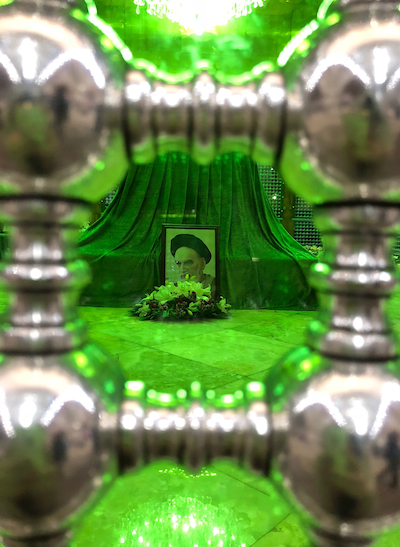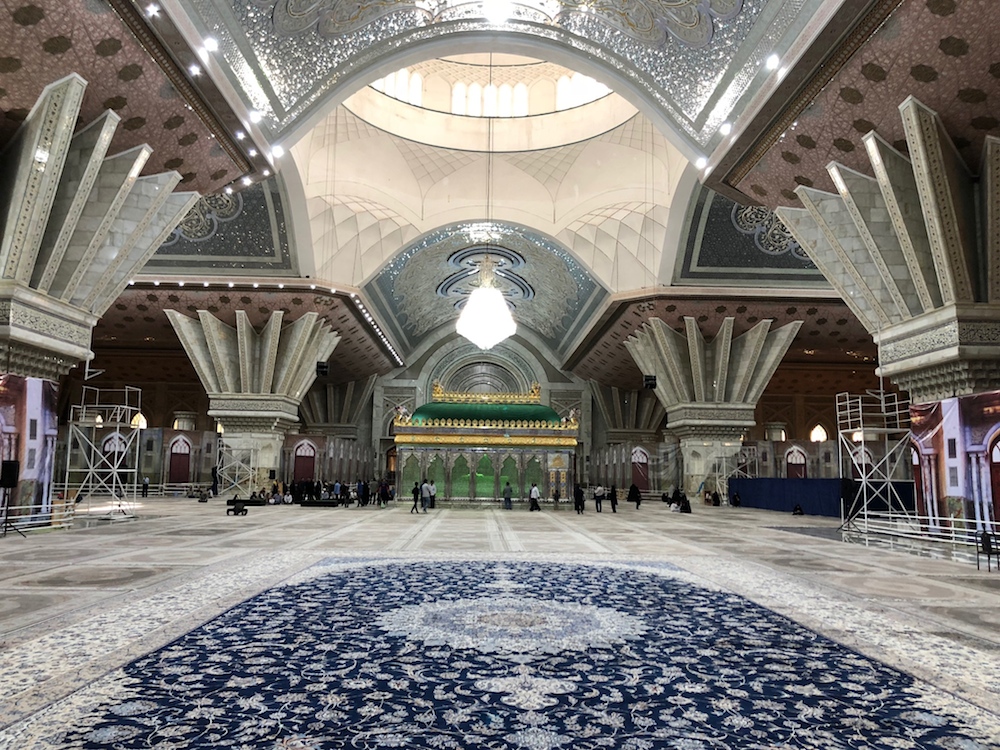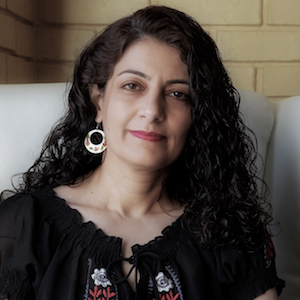Essay by Mojgan Ghazirad
Not a Single Strand of Hair

Three years ago, when I visited Tehran during the summer, my mother insisted we visit Bagher Shahr, a suburban area in the southern part of the city. I was reluctant to go with her. I didn’t have the appropriate attire to stroll on the unfamiliar streets in that area of Tehran. But she said she wanted to show me something I needed to see.
I covered my hair with the “Starry Night” silk scarf I’d bought from the National Gallery of Art in Washington, D.C. and wore a light cloak to keep cool from the sweltering August heat. We rode the “women’s car” on the Metro’s Line 1, which connects the high mountains of Alborz to the hollow valleys near Behesht Zahra, Tehran’s biggest cemetery. Bagher Shahr is three stops before the last.
During the ride, I noticed how the commuters’ appearances had changed since my rides on the city bus as a teenager in the 1980s. I was surprised by the abundance of smartphones. A young girl sitting close to me had tucked her scarf behind her ears, listening to loud music with her headphones. Her cheap bangles clinked as she danced in her seat to the song of an Iranian pop singer. Another woman, her black chador sun-faded, texted throughout the ride. The little girl on her lap constantly whined, trying to take the mobile from her mother’s hand. This was not the Iran I’d left behind fifteen years ago.
We got off at the Bagher Shahr station and hailed a cab. Driving south on Old Qom Road, we were surrounded by gray land with scarce yellow grass. In the orange polluted air that glowed on the horizon, I recognized the golden dome of Ayatollah Khomeini’s Mausoleum. On the right side of the road, with four free-standing minarets glittering, it’s a structure no one could miss. Still under construction, the mausoleum was founded after Khomeini’s death in 1989.
The taxi driver glanced at his rearview mirror, noting my unusual hijab. “Have you ever visited Khomeini’s tomb?”
“No,” I said, adding that I’d been living outside the country for awhile.
“You should,” he said. “It’s incomparable to any structure you’ve seen.”
I remained silent, unwilling to open up a conversation with another taxi driver in Tehran. They almost always asked me serial questions about living in America. I didn’t take his compliment about Khomeini’s Mausoleum seriously, either, assuming it looked grand in the eyes of the people who lived in that neighborhood. If he’d seen other ancient monuments and mosques in Iran, I doubted he’d be so impressed.
I was sixteen when Khomeini died, and all I remember from those dark days is that schools closed and millions of mourning men gathered around a glass coffin where the Ayatollah’s body, shrouded in white cotton, had been placed on display. Days passed until the authorities decided where to bury the founder of the Islamic Republic. The devoted followers paying tribute to their beloved spiritual leader didn’t want to let go of his remains. They clung to his body; the shroud got torn apart. Officials had to fly the body with a helicopter to his burial place before the followers reached the site.
No one praised Khomeini’s movement in our house. My father had been a high-ranking officer in the Shah’s army and an ardent supporter of his secular reforms. He was a tough critic of the ideals of the Islamic Republic and truly believed the Islamic Revolution of 1979—led by Ayatollah Khomeini—was a total disaster for Iran. We all ended up leaving the country as the new republic became established.
My mother and I left the taxi in front of Tehran’s Protestant Cemetery, then paced north from there on Old Qom Road. The small graveyard looked peacefully green amid the gray clay around it. Two marble stones on the sides of the main entrance, etched in Farsi and English, explained that the cemetery had been built in 1970 and was governed by the US and various European embassies. As the majority of Iranian Christians are Armenian Apostolics and Catholics, it’s a lonely resting place for foreigners who died during their service in those embassies. Until the 1979 Revolution, it had been managed by American Presbyterian clergies.
“We’re close,” my mother said finally, as we passed the northern edge of the cemetery. “From here, our property starts.” She nudged the ground with her shoes and drew an indentation in the dust to show me the border of the land that had once belonged to my grandfather.
Twenty years ago, when he was alive, farmers planted vegetables in that area. But years of drought had left the earth barren, and with my grandfather’s passing, no farmer remained to work on the land. It became a perfect target for Bagher Shahr municipality. Because of the vicinity of Khomeini’s Mausoleum, which attracts thousands of tourists every day, new construction has boomed, reviving the once-desolate town with new restaurants, hotels, and gathering halls.
We walked a good fifteen minutes around my grandfather’s property, the land parched under the scorching sun. We passed the municipality building and reached a newly built reception hall. On a giant storefront sign, Elegant Palace had been written in Farsi in a gilded font, as if someone wanted to slap the luxury of the hall in visitors’ faces. Behind the tall window, I saw a man with a full beard sitting behind a long birch table and beading a rosary. He talked to another man who had his hands folded over his paunch and reclined on a leather sofa. We knew they were the newly rich who’d bought the property from the municipality, renting the reception hall for funeral ceremonies.
“Prayer for the dead on a confiscated land!” My mother shook her head.
Decades ago, Khomeini had ordered the confiscation of houses owned by those who fled Iran after the Revolution. Spacious homes in northern Tehran had been divided by ugly brick walls or oilskin tent cloths and inhabited by famished families, tens of them squeezed into a single house, sharing the kitchen and the bathrooms. The walls of those mansions had been painted with the Ayatollah’s famous saying:
I will not exchange a single strand of hair belonging to the poor with the palaces of the rich in this land.
For twelve years, my mother and her siblings had struggled with the municipality to claim their land back in various Islamic courts. Even though they possessed the ownership documents, the judges kept coming up with new excuses to defer the final decision. In the meantime, the municipality had constructed every imaginable structure in Bagher Shahr, selling it to the new millionaires with ties to the government. My mother’s story was only one among the thousands who sought justice from the corrupted Islamic courts of Iran. Most of the time, people with no connection to higher authorities came away with empty hands, as my mother and her family had.
 At the end of our visit, I asked her if we could go to Khomeini’s Mausoleum on the way back. “Maybe the taxi driver wasn’t bragging after all,” I said.
At the end of our visit, I asked her if we could go to Khomeini’s Mausoleum on the way back. “Maybe the taxi driver wasn’t bragging after all,” I said.
My mother looked into my eyes, as if I’d told her aliens had landed on Earth. “What’s there for you to see?”
“At least it’s cool in that place,” I said.
She might have argued with me years before, when she had more stamina. But I took her hesitation as a yes, and soon we were at the main entrance of the mausoleum.
The building has five main entrances, one of which is dedicated to female visitors. A lady in a black chador with walky-talky in hand blocked our way. “You need to wear a chador before you go in.” She showed us a pile in a bucket beside the door. I took a random floral chador and put it over my “Starry Night” scarf. She inspected my bag, giving me an inquisitive look from head to toe. I was not the usual visitor.
Cool, fresh air caressed our cheeks as we stepped inside. I raised my head, trying to guess the height of the palatial structure. As hard as I tried to imagine the shrines I’d visited during my childhood travels to Qom and Mashhad, I couldn’t bring myself to compare this magnificent edifice with them. Those shrines had the serenity of a sacred place, where I could concentrate and pray. The broken-mirror art on their walls reflected the light from chandeliers, illuminating their interiors like pure shining stars.
In contrast, I now felt as if I were standing under a giant tent erected on top of a grand jewelry box that bore the Ayatollah’s body. Calligraphic sentences from the holy Koran embellished every marble arch and high window. Broad pillars of furbished marble held the weight of the building, and the ceiling was decorated with fine rose-tinged quartz, golden stars embedded in between. I’d never seen that pink stone used in any mosque in Iran. It was a color so rare for decorating a religious edifice that I wondered where the stones could have come from.
Visitors milled around the huge rectangular tomb in the center of the mausoleum. Emerald light emanated from inside the sepulcher through a metallic lattice frame. A high snow-white dome nested over the tomb, and hundreds of delicate squinch arches supported the dome on an octagonal base. Sunrays seeped through the clerestories at the dome’s base, and some squinches were decorated with tiny mirrors. I could only imagine what the dome will look like once all those concentric arches are tiled with mirrors, reflecting the light thousands of times.
Bewitched, I heard an old woman weeping beside me. She’d grabbed the lattice frame, her knuckles protuberant, and was whispering affectionate words to the picture of Ayatollah Khomeini inside the tomb. The shadow of the lattice frame sketched glowing green squares on her face. Her ragged chador had slipped back on her head, revealing gray hair and the front vest of a shabby cloak. She unwrapped a green silk thread from her wrist and tied it around one of the crosses of the lattice frame. She kissed the frame, stepped back from the tomb, and trudged away with her cane.
She was not the only pilgrim at that place. Waves of visitors brushed the lattice frame and whispered odes to the Ayatollah. The leader of the Islamic Revolution had become a saint for the poor, many of whom were said to visit the mausoleum every day.
“Where is that Imam of the oppressed?” my mother whispered, as she watched the pilgrims kissing the frame.
My eyes remained glued to the fine rugs that covered every inch of the mausoleum. Hundreds of them carpeted the polished marble floors. The fish-bone pattern woven in the orchid-pink background would be hard to miss for any Iranian familiar with expensive Persian carpets. I wondered if the young women who’d woven those rugs in villages scattered across the country knew they would end up in Khomeini’s Mausoleum—in the final home of the man who claimed his Islamic way of governing the country would bring equality and justice to all.
We dumped the floral chadors back into the bucket as we exited. I rearranged my “Starry Night” scarf while we walked toward a few wooden gazebos scattered in the green park around the construction site. The scaffolds were still attached to the outer walls, and men were working on the façade. We sat under an empty gazebo and drank the bottled water we’d brought from home.
My mother opened a small container of dates and walnuts, offering them to me. “What happened to his fiery sermons about equality and justice he enunciated every Friday?” She glanced up at the mausoleum's dome.
I took a date and remained silent.
A little boy in a tattered T-shirt came close, begging us to buy something from the collection of rosaries and pocket prayer books he carried in two clear plastic bags. His eyes looked sunken in his sunburned face. I took a rosary and gave him ten-thousand tomans. He smiled, snatching the bill and tucking it deep into his pocket. Then he hopped away in joy, forgetting for a few moments that he was supposed to be selling the rosaries and the prayer books to other pilgrims and tourists.
I examined the rosary in my hand. The beads looked similar to the quartz that coated the mausoleum’s ceiling—the same pink hue, except these were tawdry and fake.
In the afternoon, the spires of the golden minarets scratched the blazing sky. The mausoleum’s dome glistened like a rare jewel on top of the soft sand dunes of the Kavir Desert. So much wealth had been packed into that parched land. As we walked toward the Haram metro station, we saw pastries, perfumes, prayer rugs, and posters of Ayatollah Khomeini and his successor in the stores that faced the park. Among them, I noticed a bookstore dedicated to the Ayatollah’s books of fatwas, key speeches, and poems. A giant effigy of him sitting on a covered sofa hung on the wall behind the display window.
Memories flooded me as I saw him in that pose. Ayatollah Khomeini used to give sermons from a small brick balcony in Jamaran Hosseinieh, a dilapidated house of prayer in a village in northern Tehran. He specifically chose that place for his residence after he came back to Iran from exile, drawing a sharp contrast between his humble way of life and the luxurious lifestyle of the former Shah of Iran. Every Friday, he sat on the worn-out sofa, covered by a white sheet, and talked about Iran’s pivotal role in distributing Islam to the world. He condemned Saddam Hussein and America—the Great Satan, in his words—and promised paradise to the seekers of Allah. He hailed the audience from the balcony, while they threw their fists in the air, wishing death to America and every superpower in the world. The devotees sometimes tried to climb the balcony or held their children in the air to be blessed by Ayatollah’s hands.
His persona in the media projected simplicity and humility. But his mausoleum now stands at odds with the words of the man who cherished the destitute and alienated the rich, an elegant tomb that conjures nothing but prodigality in the eyes of the beholder. One glance at the pilgrims visiting the extravagant edifice reveals the truth about the economic status of ordinary Iranians. It’s a clear derailment of the Islamic Republic, which once claimed to be the patron of the poor.
In the bookstore, a young man recited verses from the Koran in a melancholy voice. They resonated with a song I’d often heard on the national radio years before. Farhad, the Iranian revolutionary singer, started that song with a verse attributed to Mohammad, Prophet of Islam: A state may survive under infidelity, but will certainly fade with injustice.

Publishing Information
- The “single strand of hair” quote is from An Anthology of Imam Khomeini’s Speeches, Messages, Interviews, Decrees, Religious Permissions and Letters (Volume 14), compiled, by Sahifeh-ye Imam; technical editing by Majid Karimi and Mansoor Limba with multiple translators (Institute for Compilation and Publication of Imam Khomeinī's Works, International Affairs Department, 2008).
- The quote attributed to Mohammad is from A Collection of Twenty Essays by Morteza Motahhari (Sadra Publications, 20th edition, 2004).
Art Information
- Photos of Ayatollah Khomeini’s Mausoleum © Mojgan Ghazirad; used by permission.
 A native of Iran, Mojgan Ghazirad graduated from Tehran University with a medical degree. She studied pediatrics at Virginia Commonwealth University and received her neonatal medicine specialty from George Washington University. She currently works as a neonatologist in Washington, D.C. Her short stories have appeared in Persian literary magazines such as Zanan and Hengam. She has published three collections of short stories in Farsi in Iran and Europe. She holds an MFA in creative writing from Southern New Hampshire University and is working on her memoir, The House on Sun Street, which depicts her memories of growing up in Tehran during and after the Iranian Islamic Revolution.
A native of Iran, Mojgan Ghazirad graduated from Tehran University with a medical degree. She studied pediatrics at Virginia Commonwealth University and received her neonatal medicine specialty from George Washington University. She currently works as a neonatologist in Washington, D.C. Her short stories have appeared in Persian literary magazines such as Zanan and Hengam. She has published three collections of short stories in Farsi in Iran and Europe. She holds an MFA in creative writing from Southern New Hampshire University and is working on her memoir, The House on Sun Street, which depicts her memories of growing up in Tehran during and after the Iranian Islamic Revolution.
Follow Mojgan Ghazirad on Twitter @MojganGhazirad.
